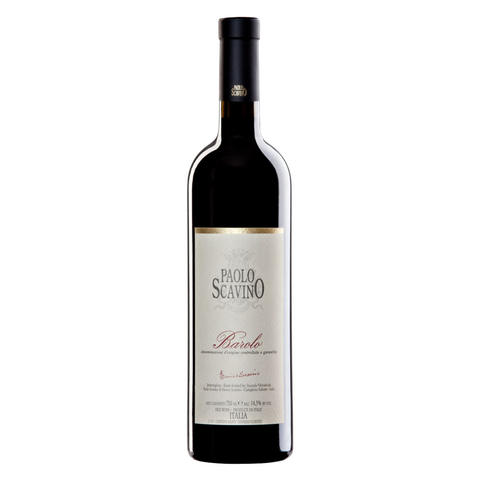
2020 Paolo Scavino Barolo, Piedmont, Italy - 1.5L MAG
Vivid aromas of red berries and roses follow through to a medium-bodied palate, where fine tannins provide a lightly firm bed for fresh fruit. The lighter, brighter style of this is true to the character of the vintage, but here it’s been well-handled. All in balance.
ABOUT THIS WINE
This Barolo has a special value for their family and represents the history and tradition of blending different cru of Barolo.
The Barolo comes from the best plots of seven cru. The diversity of soils, exposure and altitude characterizes each of these small but very important terroir. Unifying these diversities, the Barolo offers harmony and complexity with an overall character of the zone.
Separate vinification. Destemming and light crushing. The maceration and the alcoholic fermentation are in stainless steel with temperature controlled and indigenous yeasts. Malolactic fermentation in oak barrels. The tartaric stabilization occurs naturally during the winter with the low temperatures.
Every plots of the crus is kept separate and aged in neutral French oak barrels for 10 months and further 12 months in large casks. Final blend as a result of a further selection in the cellar of the most performing plots of the vintage. Approximately one year of stainless steel and 10 months of bottle aging before release.
ABOUT THIS PRODUCER
The most remarkable thing about Enrico Scavino is that even today, this man ever longs to make better Barolo. Generations at the helm of his family estate, founded in 1921, have already proven him a leader in the qualitative advances that have occurred in the Barolo area. And yet, he has never stopped the experimentation that has always kept him on the avant-garde of the Langhe area. He continues to vinify his wines parcel by parcel, taking advantage of these small fermentations to try to make better wines. In fact, in 2007 Enrico has even designed and fabricated his own fermentation vessel, used exclusively on his Barolo, to improve the finesse of extraction from his nebbiolo. Now with his daughters Elisa and Enrica working with him full-time, it would seem possible for this statesman—contemporary of Domenico Clerico and Elio Altare—to take a step back. Instead, Enrico’s passion is further bolstered by the presence of the next generation! And speaking of family, I’d be remiss not to mention that Enrico’s first cousin and neighbor is Luigi Scavino of Azelia fame. Alfonso, father of Luigi, and his brother Paolo, father to Enrico, divided ownership of the 11 hectare Scavino farm in the 1950s, giving each an equal share of the famed Fiasco hill.
Winemaking at the estate has evolved over time—but the one constant, even from the days of Enrica and Elisa’s grandfather, was hygiene: the cleanliness of the winery and health of the grapes remain paramount. Technology has had its influence: Enrico recalls working the vineyards with oxen and horses, and said of the purchase of his first tractor “I couldn’t have been happier if my father had gifted me a Ferrari!” In 1993, rotofermentors arrived at the estate, and between 1996-1999, Slavonian casks were replaced with French oak—but barriques here were always and only used for the first 10 months of aging to help fix color before the wines were transferred to larger oak botti. The percentage of new oak has been much reduced from a height of 30% from the 1990s to 2004, to only 20% new from 2004 – 2008, 17% new in 2011 & 2012, and for the 2015 harvest they have even reduced to a further 14% new. Quality control is crucial. Scavino could make more wine—but the estate chooses to sell off from 10-30% of the production in bulk to maintain their super high standards. This small family farm—which essentially started with 5.5 hectares—now manages 29 hectares of vineyards, and regularly finds itself classified amongst the other top estates of the region.
Details:
| Grape(s) | Nebbiolo |
| Farming | Sustainable |
